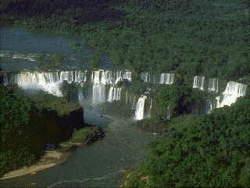![]()
|
|
WATERS AND MARSHES - Introduction |
|
|
|
 The star of the great waters is undoubtedly Iguazú "great rivers" in the langauge of the Guaranies Indians). The falls are located in the northwestern corner of the province of Misiones, 1400 kms from Buenos Aires. These beautiful 275 falls, reaching up to 70 meters, are surrounded by the virgin jungle of the Iguazú National Park, protecting over 2000 flora and 400 bird and wild animal species. The star of the great waters is undoubtedly Iguazú "great rivers" in the langauge of the Guaranies Indians). The falls are located in the northwestern corner of the province of Misiones, 1400 kms from Buenos Aires. These beautiful 275 falls, reaching up to 70 meters, are surrounded by the virgin jungle of the Iguazú National Park, protecting over 2000 flora and 400 bird and wild animal species.
Two thirds of the falls are within Argentine limits, but both sides (Argentine and Brazilian) should be explored to appreciate the whole beauty of the area. Walk along the pathways, cross bridges and marvell at these natural wonders of the world. Having a stroll along the walkways before breakfast is true pleasure, boat and jungle safari excursions thrilling, and so is bird watching. November is an ideal month for visiting this otherwise humid and hot region, the disadvantage being that it is high season (international meetings, seminars and congresses), so an early booking is advisable. There are lots of good hotels to stay but those close to the falls themselves (either on Argentina or Brazilian side) are an ideal option. I must admit I am biased on the one on our Argentine side. The hotel is ideally located close to the falls and protected form the hustle and bustle of everyday tourism. The Brazilian one is beautiful and close to the falls, bus just opposite the street in the midst of traffic noise of buses, cars and people coming and going. A few kms from the Falls is the 8 km long Itaipu Dam considered a masterpice of engineering with a spillway that can pour 60.00 m2 per second, a channel and a lake with a surface of 1350 km. There are other waterworlds in Argentine northern area and those located in the province of Formosa are true challenges for adventurers. Formosa is one of the poorest regions in Argentina, least known as a tourist attraction, but undoubtedly a true nature reserve of the world. There is the dry Chaco and the wet Chaco (the Great fascinating inhospitable, adventurous Chaco), between Bermejo and Pilcomayo rivers, jungle and wetlands with jaguars, toucans, caymans etc. Chaco coming from chacu (meaning hunting) is located where both rivers play hide and seek until naturally joining Paraguay or Paraná rivers. The province´s main peculiarity is Bañado Estrella, compared with Ibera wetlands in Corrientes and Pantanal in Brazil. The three of them are considered important ecological reserves in South America. And there is more to explore in that area : Riacho Monte Lindo, Laguna Herradura and the Pilcomayo National Park with savannahs, palm forests, jungles and bird filled wetlands around Laguna Blanca in the northeastern part of the province. You will find information about Ibera under Marshes |

